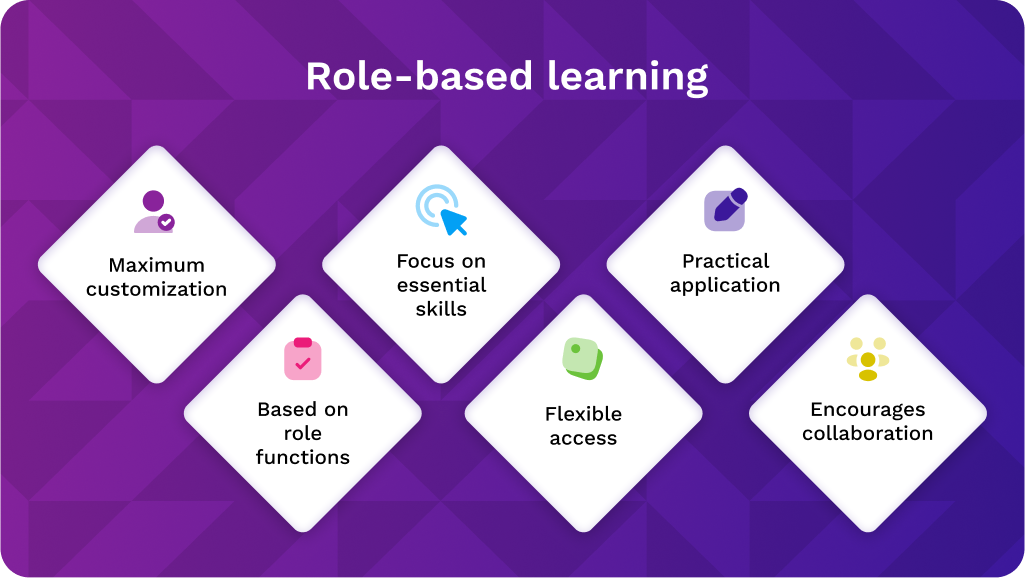Table of contents
ToggleRob Liano, American Writer posed the following question: “Knowledge is power? No. Knowledge on its own is nothing, but the application of useful knowledge, now that is powerful.” This observation forms the foundation of role-based learning, a training approach that allows a company’s employees to acquire all the skills and knowledge they need to thrive in the workplace.
What is this approach and what are its advantages? And how can it be successfully applied in a company? In this article, we’ll discover how to transform knowledge into powerful action and dramatically boost your teams’ work performance.
First off: what is role-based learning?
Role-based learning is an educational approach that provides each student with a customized learning experience based on their specific role and responsibilities within an organization. Rather than simply offering the same generic method to all, role-based learning adapts to the needs of these different professional roles, giving students precisely tailored content designed to equip them with the skills they need for success.
Key features of role-based learning
- Personalized training adapted to each role.
- Precise information directly related to specific tasks.
- A focus on essential skills.
- Flexible access to learning based on different learning styles.
- An emphasis on the practical application of skills in the workplace.
- Promotes teamwork and communication.
Why you should consider role-based learning for your company: 4 key benefits
Many employees claim to feel overtrained in fields such as interpersonal skills, but undertrained in other core competencies that are crucial to their daily tasks.
Role-based training addresses that challenge by ensuring that employees receive information that is directly relevant to their daily responsibilities. However, role-based learning also provides other important benefits for both individual workers and the wider company, including:
Optimized time and resources
By focusing on the essential skills needed for each role, role-based learning optimizes the use of training time. This avoids wasting resources on irrelevant content, translating into more efficient learning and greater productivity.
Increased motivation and commitment
Tailored training fosters a sense of belonging in employees, and creates a direct connection between training and individual success at work. This, in turn, increases employee motivation and engagement, as they get to see exactly how their learning contributes to their professional development.
Greater employee adaptability
As an organization evolves, so too do the demands and responsibilities of its workers. Role-based training allows companies to keep pace with these changes, ensuring that employees are always equipped with the right skills to meet the challenges that come their way.
Improved organizational collaboration
By aligning training with the specific goals of each role, role-based learning fosters a deeper understanding of individual roles, ultimately improving collaboration between team members. This in turn generates greater organizational coherence – an atmosphere where each employee clearly grasps their role and contributes effectively to the overall success of the company.
From theory to action: Implementing a successful role-based training strategy
According to Training Industry, the typical employee only dedicates 1% of their work week to training. That equates to just 4.8 minutes a day and 24 minutes a week. It’s crucial for L&D leaders to make the most of that 1%.
Effectively implementing a role-based training strategy is key to ensuring that employees acquire the skills and knowledge they need to excel in their individual roles. Below are some practical tips to help you achieve this:
1. Identify key competencies
Before making a start on training proper, it’s essential to identify the key skills needed for each role within the organization. Collaborating with team leaders and HR professionals will give you a deeper insight into the specific skills each employee needs to develop.
2. Personalize learning content
Make sure that any learning content you provide is specific and relevant to each role. Customize training materials, modules, and case studies to address the unique responsibilities and challenges associated with each position.
3. Use innovative technology
Integrate innovative technologies into training, such as interactive simulations, virtual reality, or advanced online learning platforms. These tools not only make training more engaging, but also create more immersive and effective learning experiences.
4. Take advantage of practical training methods
Learning by doing is a methodology based on experimentation, and acquiring skills that allow students to learn to solve problems in real life. Practice is the key to this approach, which aims to take advantage of two key factors: emotions and risk. Emotions such as stress, surprise or joy are awakened when trying to perform a task successfully, while risk is the possibility that we might fail in doing so. Human beings tend to learn from their mistakes in order to better deal with both of these factors.
At isEazy Skills, learning by doing is the foundation of our formula for talent development. Our courses and programs seek to create an immersive experience in which employees have to overcome practical situations and examples taken from real life. This helps them to develop their soft skills and digital abilities through the proven framework of role-based learning.
5. Involve supervisors and leaders
The support employees receive from those in a senior position is essential. It reinforces the importance of training and ensures that any skills learned are transferred effectively into the work environment.
6. Constantly evaluate and adjust
Role-based training is not a static method, but rather dynamic – it should naturally evolve with the changing needs of both the company and the market. To help this process along, carry out regular evaluations of training effectiveness, and make any adjustments necessary in order to consistently ensure the relevance of training.
Videos, role-playing and apps: Examples of role-based learning for your teams
The advantages of role-based training are clear, but what does the approach look like in practice? Role-based learning can be carried out through various training methods especially adapted to specific roles. Take a look at these examples and note down the ideas that can be applied to your teams:
- Videos: Design instructional videos to demonstrate specific procedures, illustrate best practices, and explain the proper use of tools. These videos will provide employees with visual resources that they can review as needed to improve their daily performance.
- Simulations: Simulations are helpful to recreate specific work-related challenges. Employees can participate in virtual scenarios that mimic real-life situations, allowing them to practice and hone their skills in a controlled environment. Thanks to recent advances in virtual reality within the field of e-learning, this type of learning can prove highly immersive and effective.
- Role-play: Another potential strategy is to implement virtual role-plays that emulate typical situations in the work environment. This allows employees to practice their decision-making, problem-solving and communication skills, improving these abilities as well as their general adaptability.
- Educational podcasts: These can include interviews with experts, analyses of industry trends, or discussions of common, everyday challenges at work.
- Training Apps: These apps work by offering content specifically tailored to each job role, allowing users to gain skills and knowledge directly relevant to their unique responsibilities. Additionally, a training app ensures that employees can learn at whatever time best matches their schedules, making it easy to integrate training naturally into their workflow. If this option sounds intriguing to you, then you should get to know the features of IsEazy Engage.
Altogether, we can see that role-based learning is a highly powerful tool which enables employees to better understand their job roles, gain the skills and knowledge necessary to make progress, and finally master the wider company’s objectives and goals.
If you’re seeking to boost your employees’ performance, then implementing role-based learning can be a key element in your strategy for success. As Training Industry explains, “employees have a need and a desire for training that is relevant to what they really do.”















